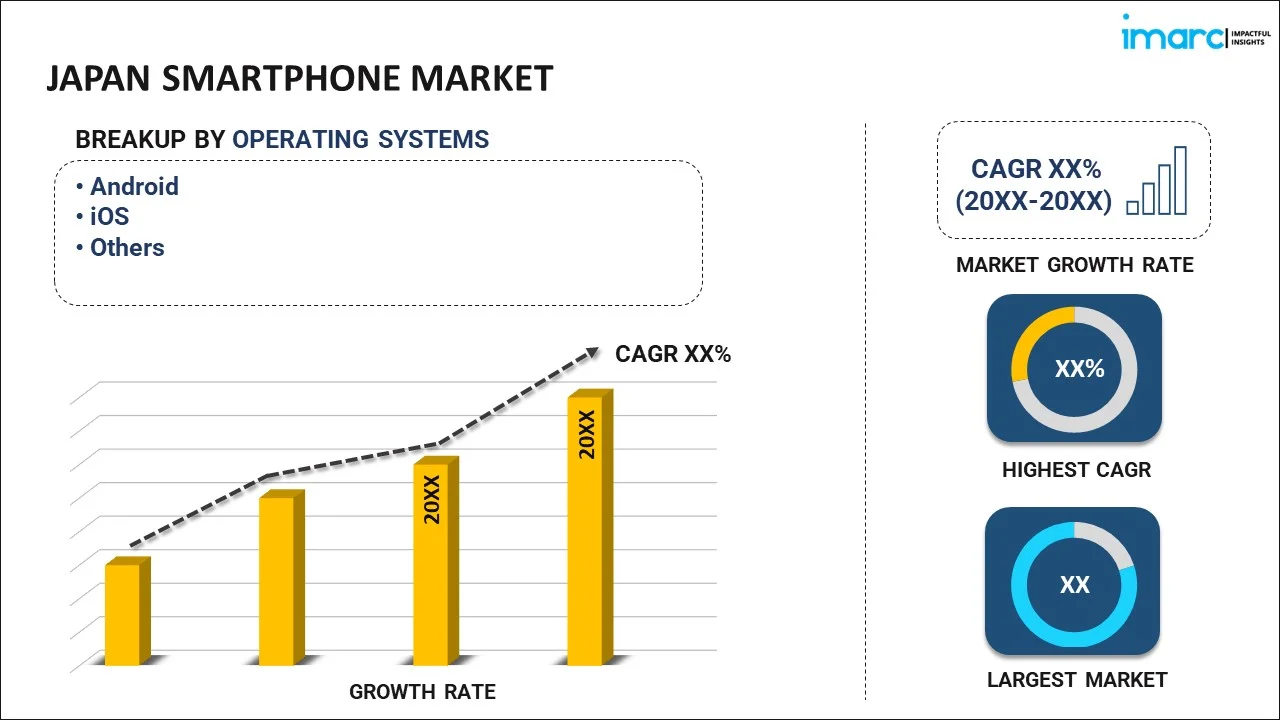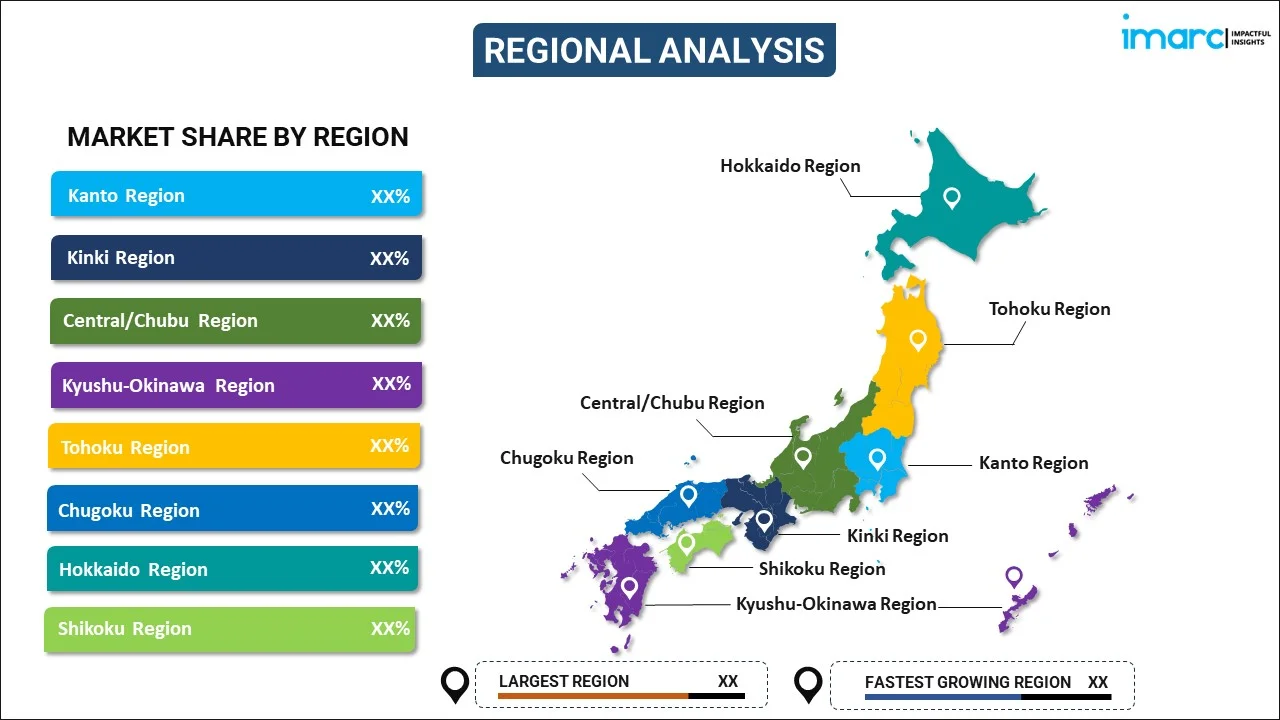
Japan Smartphone Market Report by Operating System (Android, iOS, and Others), Display Technology (LCD Technology, OLED Technology), RAM Capacity (Below 4GB, 4GB - 8GB, Over 8GB), Price Range (Ultra Low-End (Less Than $100), Low-End ($100-<$200), Mid-Range ($200-<$400), Mid- to High-End ($400-<$600), High-End ($600-<$800), Premium ($800-<$1000) and Ultra-Premium ($1000 and Above)), Distribution Channel (OEMs, Online Stores, Retailers), and Region 2025-2033
Market Overview:
The Japan smartphone market size reached 31.9 Million Units in 2024. Looking forward, IMARC Group expects the market to reach 51.2 Million Units by 2033, exhibiting a growth rate (CAGR) of 5.1% during 2025-2033. The widespread adoption of advanced mobile technologies, the growing demand for connectivity, and the widespread integration of augmented reality (AR) and virtual reality (VR) technologies in smartphones represent some of the key factors driving the market.
|
Report Attribute
|
Key Statistics
|
|---|---|
|
Base Year
|
2024 |
|
Forecast Years
|
2025-2033
|
|
Historical Years
|
2019-2024
|
| Market Size in 2024 | 31.9 Million Units |
| Market Forecast in 2033 | 51.2 Million Units |
| Market Growth Rate (2025-2033) | 5.1% |
A smartphone is a mobile device that combines the functionalities of a cellular phone with those of a handheld computer. It is designed to offer various features, including voice calls, text messaging, internet browsing, email, multimedia capabilities, and access to a wide array of applications. Smartphones are equipped with advanced operating systems that enable users to install and run applications, providing them with a personalized experience. The devices typically feature touchscreens that facilitate intuitive user interactions, and they can connect to the internet through cellular networks or Wi-Fi, ensuring seamless access to information and services. Smartphones have become an integral part of modern life, enabling individuals and businesses alike to stay connected, productive, and informed on the go. Smartphones have evolved to include mobile payment integration, allowing users to make secure transactions using their devices. Popular mobile payment platforms, such as Apple Pay and Google Pay, utilize near-field communication (NFC) technology to enable contactless payments at supported retail outlets. This convenient feature has transformed how consumers conduct financial transactions, making smartphones not just communication devices but also digital wallets.
Japan Smartphone Market Trends:
The Japan smartphone market has witnessed significant growth and innovation fueled by the widespread adoption of advanced mobile technologies and the growing demand for connectivity. The nation's consumers actively seek smartphones that offer high-speed data connectivity, seamless communication, and access to a vast array of applications and services, which has led to a steady rise in smartphone sales. Moreover, the Japanese smartphone market is driven by the continuous evolution of mobile ecosystems. Manufacturers and software developers continually introduce new and improved features, leading to enhanced user experiences and increased demand for upgraded devices. The introduction of augmented reality (AR) and virtual reality (VR) technologies in smartphones, for instance, has transformed gaming and entertainment experiences, captivating consumers and stimulating market growth. Additionally, the integration of artificial intelligence (AI) capabilities into smartphones has enabled intelligent personal assistants and improved device performance, further enticing consumers to upgrade to newer models. Also, the market is witnessing a growing trend of mobile workforce management and enterprise mobility solutions. With businesses seeking greater efficiency and productivity, smartphones have become indispensable tools for employees, enabling them to stay connected, access critical information, and collaborate in real-time. Companies are increasingly adopting mobile-centric strategies and applications, driving the demand for smartphones tailored to business needs. Furthermore, environmental consciousness has become a prominent factor influencing the Japan smartphone market. Consumers are now more inclined to choose smartphones that are energy-efficient and environmentally friendly. Manufacturers are responding to this demand by introducing eco-friendly devices that incorporate recyclable materials and feature energy-saving technologies. Such initiatives not only resonate with environmentally conscious consumers but also align with the nation's sustainability goals, making them a crucial element in the market's growth trajectory.
Japan Smartphone Market Segmentation:
IMARC Group provides an analysis of the key trends in each segment of the Japan smartphone market report, along with forecasts at the country level for 2025-2033. Our report has categorized the market based on operating system, display technology, RAM capacity, price range, and distribution channel.
Operating System Insights:

- Android
- iOS
- Others
The report has provided a detailed breakup and analysis of the market based on the operating system. This includes android, iOS, and others.
Display Technology Insights:
- LCD Technology
- OLED Technology
A detailed breakup and analysis of the Japan smartphone market based on the display technology has also been provided in the report. This includes LCD technology and OLED technology.
RAM Capacity Insights:
- Below 4GB
- 4GB - 8GB
- Over 8GB
The report has provided a detailed breakup and analysis of the market based on the RAM capacity. This includes below 4GB, 4GB - 8GB, and over 8GB.
Price Range Insights:
- Ultra Low-End (Less Than $100)
- Low-End ($100-<$200)
- Mid-Range ($200-<$400)
- Mid- to High-End ($400-<$600)
- High-End ($600-<$800)
- Premium ($800-<$1000) and Ultra-Premium ($1000 and Above)
A detailed breakup and analysis of the Japan smartphone market based on the price range has also been provided in the report. This includes ultra low-end (less than $100), low-end ($100-<$200), mid-range ($200-<$400), mid- to high-end ($400-<$600), high-end ($600-<$800), and premium ($800-<$1000) and ultra-premium ($1000 and above).
Distribution Channel Insights:
- OEMs
- Online Stores
- Retailers
The report has provided a detailed breakup and analysis of the market based on the distribution channel. This includes OEMs, online stores, and retailers.
Regional Insights:

- Kanto Region
- Kinki Region
- Central/ Chubu Region
- Kyushu-Okinawa Region
- Tohoku Region
- Chugoku Region
- Hokkaido Region
- Shikoku Region
The report has also provided a comprehensive analysis of all the major regional markets, which include Kanto Region, Kinki Region, Central/ Chubu Region, Kyushu-Okinawa Region, Tohoku Region, Chugoku Region, Hokkaido Region, and Shikoku Region.
Competitive Landscape:
The report has also provided a comprehensive analysis of the competitive landscape in the market. Competitive analysis such as market structure, key player positioning, top winning strategies, competitive dashboard, and company evaluation quadrant has been covered in the report. Also, detailed profiles of all major companies have been provided.
Japan Smartphone Market Report Coverage:
| Report Features | Details |
|---|---|
| Base Year of the Analysis | 2024 |
| Historical Period | 2019-2024 |
| Forecast Period | 2025-2033 |
| Units | Million Units |
| Scope of the Report | Exploration of Historical and Forecast Trends, Industry Catalysts and Challenges, Segment-Wise Historical and Predictive Market Assessment:
|
| Operating Systems Covered | Android, iOS, Others |
| Display Technologies Covered | LCD Technology, OLED Technology |
| RAM Capacities Covered | Below 4GB, 4GB - 8GB, Over 8GB |
| Price Ranges Covered | Ultra Low-End (Less Than $100), Low-End ($100-<$200), Mid-Range ($200-<$400), Mid- to High-End ($400-<$600), High-End ($600-<$800), Premium ($800-<$1000) and Ultra-Premium ($1000 and Above) |
| Distribution Channels Covered | OEMs, Online Stores, Retailers |
| Regions Covered | Kanto Region, Kinki Region, Central/ Chubu Region, Kyushu-Okinawa Region, Tohoku Region, Chugoku Region, Hokkaido Region, and Shikoku Region |
| Customization Scope | 10% Free Customization |
| Post-Sale Analyst Support | 10-12 Weeks |
| Delivery Format | PDF and Excel through Email (We can also provide the editable version of the report in PPT/Word format on special request) |
Key Questions Answered in This Report:
- How has the Japan smartphone market performed so far and how will it perform in the coming years?
- What has been the impact of COVID-19 on the Japan smartphone market?
- What is the breakup of the Japan smartphone market on the basis of operating system?
- What is the breakup of the Japan smartphone market on the basis of display technology?
- What is the breakup of the Japan smartphone market on the basis of RAM capacity?
- What is the breakup of the Japan smartphone market on the basis of price range?
- What is the breakup of the Japan smartphone market on the basis of distribution channel?
- What are the various stages in the value chain of the Japan smartphone market?
- What are the key driving factors and challenges in the Japan smartphone?
- What is the structure of the Japan smartphone market and who are the key players?
- What is the degree of competition in the Japan smartphone market?
Key Benefits for Stakeholders:
- IMARC’s report offers a comprehensive quantitative analysis of various market segments, historical and current market trends, market forecasts, and dynamics of the Japan smartphone market from 2019-2033.
- The research study provides the latest information on the market drivers, challenges, and opportunities in the Japan smartphone market.
- Porter's five forces analysis assist stakeholders in assessing the impact of new entrants, competitive rivalry, supplier power, buyer power, and the threat of substitution. It helps stakeholders to analyze the level of competition within the Japan smartphone industry and its attractiveness.
- Competitive landscape allows stakeholders to understand their competitive environment and provides an insight into the current positions of key players in the market.
Need more help?
- Speak to our experienced analysts for insights on the current market scenarios.
- Include additional segments and countries to customize the report as per your requirement.
- Gain an unparalleled competitive advantage in your domain by understanding how to utilize the report and positively impacting your operations and revenue.
- For further assistance, please connect with our analysts.
 Inquire Before Buying
Inquire Before Buying
 Speak to an Analyst
Speak to an Analyst
 Request Brochure
Request Brochure
 Request Customization
Request Customization




.webp)




.webp)












